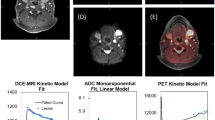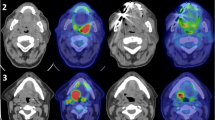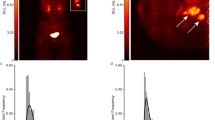Abstract
The evolving utilization of functional imaging, mainly 2-[18F]fluoro-2-deoxyglucose (18FDG) imaging, with positron emission tomography (PET) and PET/CT, is profoundly altering head and neck tumor staging approaches, radiation treatment planning, and follow-up management. Tumor–node–metastasis staging with PET/CT has improved the characterization of patient disease versus CT, MRI, or PET alone, thereby affecting patient disease management. Therefore, the utilization of PET/CT is appropriate for head and neck cancer staging in the initial presentation and in the recurrent setting. In the setting of radiation therapy treatment planning, PET-directed tumor volume contouring is not ready for clinical practice without further technological improvements in imaging specificity/sensitivity and resolution. Patient or organ motion might interfere with the accuracy of anatomical co-alignment, and variability in defining the threshold of imaging signals on PET images can affect the contour of the biological tumor volume. The use of PET/CT for staging and detecting both primary and recurrent head and neck cancer is valuable; however, its application in radiation treatment planning should be viewed as investigational.
This is a preview of subscription content, access via your institution
Access options
Subscribe to this journal
Receive 12 print issues and online access
$209.00 per year
only $17.42 per issue
Buy this article
- Purchase on Springer Link
- Instant access to full article PDF
Prices may be subject to local taxes which are calculated during checkout





Similar content being viewed by others
References
Carvalho AL et al. (2005) Trends in incidence and prognosis for head and neck cancer in the United States: a site-specific analysis of the SEER database. Int J Cancer 114: 806–816
Cooper JS et al. (2004) Postoperative concurrent radiotherapy and chemotherapy for high-risk squamous-cell carcinoma of the head and neck. N Engl J Med 350: 1937–1944
Bernier J et al. (2004) Postoperative irradiation with or without concomitant chemotherapy for locally advanced head and neck cancer. N Engl J Med 350: 1945–1952
Ginsberg LE (2002) MR imaging of perineural tumor spread. Magn Reson Imaging Clin N Am 10: 511–525
Takashima S et al. (1992) Head and neck carcinoma: detection of extraorgan spread with MR imaging and CT. Eur J Radiol 14: 228–234
Gwyther SJ (1994) Modern techniques in radiological imaging related to oncology. Ann Oncol 5 (Suppl 4): S3–S7
Antoch G et al. (2003) Non–small cell lung cancer: dual-modality PET/CT in preoperative staging. Radiology 229: 526–533
Steinert HC (2004) PET/CT in lymphoma patients. Radiologe 44: 1060–1067
Goerres GW et al. (2005) The value of PET, CT and in-line PET/CT in patients with gastrointestinal stromal tumours: long-term outcome of treatment with imatinib mesylate. Eur J Nucl Med Mol Imaging 32: 153–162
Patel PV et al. (2002) PET-CT localizes previously undetectable metastatic lesions in recurrent fallopian tube carcinoma. Gynecol Oncol 87: 323–326
Veit P et al. (2005) Whole-body PET/CT tumour staging with integrated PET/CT-colonography: technical feasibility and first experiences in patients with colorectal cancer. Gut [doi: 10.1136/gut.2005.064170]
Zangheri B et al. (2004) PET/CT and breast cancer. Eur J Nucl Med Mol Imaging 31 (Suppl 1): S135–S142
Antoch G et al. (2003) Whole-body dual-modality PET/CT and whole-body MRI for tumor staging in oncology. JAMA 290: 3199–3206
Bar-Shalom R et al. (2003) Clinical performance of PET/CT in evaluation of cancer: additional value for diagnostic imaging and patient management. J Nucl Med 44: 1200–1209
Schwartz DL et al. (2005) FDG-PET/CT imaging for preradiotherapy staging of head-and-neck squamous cell carcinoma. Int J Radiat Oncol Biol Phys 61: 129–136
Schoder H et al. (2004) Head and neck cancer: clinical usefulness and accuracy of PET/CT image fusion. Radiology 231: 65–72
Nanni C et al. (2005) Role of 18F-FDG PET-CT imaging for the detection of an unknown primary tumour: preliminary results in 21 patients. Eur J Nucl Med Mol Imaging 32: 589–592
Gutzeit A et al. (2005) Unknown primary tumors: detection with dual-modality PET/CT—initial experience. Radiology 234: 227–234
Kim EE et al. (2004) Clinical PET: Principles and Applications. New York: Springer
Clarke JC (2004) PET/CT “Cometh the hour, cometh the machine?” Clin Radiol 59: 775–776
Goerres GW et al. (2004) Why most PET of lung and head-and-neck cancer will be PET/CT. J Nucl Med 45 (Suppl 1): S66–S71
Lardinois D et al. (2003) Staging of non–small-cell lung cancer with integrated positron-emission tomography and computed tomography. N Engl J Med 348: 2500–2507
Ling CC et al. (2000) Towards multidimensional radiotherapy (MD-CRT): biological imaging and biological conformality. Int J Radiat Oncol Biol Phys 47: 551–560
Apisarnthanarax S and Chao KS (2005) Current imaging paradigms in radiation oncology. Radiat Res 163: 1–25
Ciernik IF et al. (2003) Radiation treatment planning with an integrated positron emission and computer tomography (PET/CT): a feasibility study. Int J Radiat Oncol Biol Phys 57: 853–863
Solberg TD et al. (2004) A feasibility study of 18F-fluorodeoxyglucose positron emission tomography targeting and simultaneous integrated boost for intensity-modulated radiosurgery and radiotherapy. J Neurosurg 101 (Suppl 3): S381–S389
Chao KS et al. (2001) A novel approach to overcome hypoxic tumor resistance: Cu-ATSM-guided intensity-modulated radiation therapy. Int J Radiat Oncol Biol Phys 49: 1171–1182
Dizendorf EV et al. (2003) Impact of whole-body 18F-FDG PET on staging and managing patients for radiation therapy. J Nucl Med 44: 24–29
Koshy M et al. (2005) F-18 FDG PET-CT fusion in radiotherapy treatment planning for head and neck cancer. Head Neck 27: 494–502
Paulino AC et al. (2005) Comparison of CT- and FDG-PET-defined gross tumor volume in intensity-modulated radiotherapy for head-and-neck cancer. Int J Radiat Oncol Biol Phys 61: 1385–1392
Nishioka T et al. (2002) Image fusion between 18FDG-PET and MRI/CT for radiotherapy planning of oropharyngeal and nasopharyngeal carcinomas. Int J Radiat Oncol Biol Phys 53: 1051–1057
Rahn AN et al. (1998) Value of 18F fluorodeoxyglucose positron emission tomography in radiotherapy planning of head-neck tumors. Strahlenther Onkol 174: 358–364
Scarfone C et al. (2004) Prospective feasibility trial of radiotherapy target definition for head and neck cancer using 3-dimensional PET and CT imaging. J Nucl Med 45: 543–552
Heron DE et al. (2004) Hybrid PET-CT simulation for radiation treatment planning in head-and-neck cancers: a brief technical report. Int J Radiat Oncol Biol Phys 60: 1419–1424
Golder WA (2004) Lymph node diagnosis in oncologic imaging: a dilemma still waiting to be solved. Onkologie 27: 194–199
Findlay M et al. (1996) Noninvasive monitoring of tumor metabolism using fluorodeoxyglucose and positron emission tomography in colorectal cancer liver metastases: correlation with tumor response to fluorouracil. J Clin Oncol 14: 700–708
Kostakoglu L et al. (2004) PET-CT fusion imaging in differentiating physiologic from pathologic FDG uptake. Radiographics 24: 1411–1431
Mineura K et al. (1996) Long-term positron emission tomography evaluation of slowly progressive gliomas. Eur J Cancer 32A: 1257–1560
Kubota K (2001) From tumor biology to clinical PET: a review of positron emission tomography (PET) in oncology. Ann Nucl Med 15: 471–486
Lee JK and Glazer HS (1990) Controversy in the MR imaging appearance of fibrosis. Radiology 177: 21–22
Lowe VJ et al. (2000) Surveillance for recurrent head and neck cancer using positron emission tomography. J Clin Oncol 18: 651–658
Brun E et al. (2002) FDG PET studies during treatment: prediction of therapy outcome in head and neck squamous cell carcinoma. Head Neck 24: 127–135
Hautzel H and Muller-Gartner HW (1997) Early changes in fluorine-18-FDG uptake during radiotherapy. J Nucl Med 38: 1384–1386
Rege S et al. (1994) Use of positron emission tomography with fluorodeoxyglucose in patients with extracranial head and neck cancers. Cancer 73: 3047–3058
Fukui MB et al. (2003) PET/CT imaging in recurrent head and neck cancer. Semin Ultrasound CT MR 24: 157–163
Yao M et al. (2004) The role of post-radiation therapy FDG PET in prediction of necessity for post-radiation therapy neck dissection in locally advanced head-and-neck squamous cell carcinoma. Int J Radiat Oncol Biol Phys 59: 1001–1010
Yao M et al. (2005) Can post-RT FDG PET accurately predict the pathologic status in neck dissection after radiation for locally advanced head and neck cancer? Int J Radiat Oncol Biol Phys 61: 306–307
Rogers JW et al. (2004) Can post-RT neck dissection be omitted for patients with head-and-neck cancer who have a negative PET scan after definitive radiation therapy? Int J Radiat Oncol Biol Phys 58: 694–697
Greven KM et al. (2001) Serial positron emission tomography scans following radiation therapy of patients with head and neck cancer. Head Neck 23: 942–946
Stenson KM et al. (2000) The role of cervical lymphadenectomy after aggressive concomitant chemoradiotherapy: the feasibility of selective neck dissection. Arch Otolaryngol Head Neck Surg 126: 950–956
Zimmer LA et al. (2005) The use of combined PET/CT for localizing recurrent head and neck cancer: the Pittsburgh experience. Ear Nose Throat J 84: 108–110
Bucci MK et al. (2005) Advances in radiation therapy: conventional to 3D, to IMRT, to 4D, and beyond. CA Cancer J Clin 55: 117–134
Author information
Authors and Affiliations
Corresponding author
Ethics declarations
Competing interests
The authors declare no competing financial interests.
Rights and permissions
About this article
Cite this article
Frank, S., Chao, K., Schwartz, D. et al. Technology Insight: PET and PET/CT in head and neck tumor staging and radiation therapy planning. Nat Rev Clin Oncol 2, 526–533 (2005). https://doi.org/10.1038/ncponc0322
Received:
Accepted:
Issue Date:
DOI: https://doi.org/10.1038/ncponc0322
This article is cited by
-
PET/CT Staging Followed by Intensity-Modulated Radiotherapy (IMRT) Improves Treatment Outcome of Locally Advanced Pharyngeal Carcinoma: a matched-pair comparison
Radiation Oncology (2007)
-
PET/CT in head and neck cancer
European Journal of Nuclear Medicine and Molecular Imaging (2007)
-
The dilemma of target delineation with PET/CT in radiotherapy planning for malignant tumors
Chinese Journal of Clinical Oncology (2007)
-
PET/CT today: System and its impact on cancer diagnosis
Annals of Nuclear Medicine (2006)



